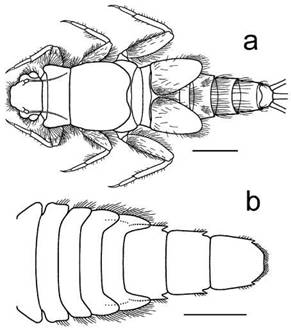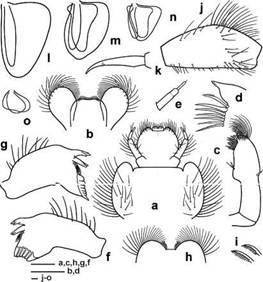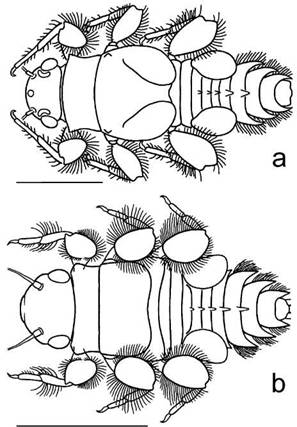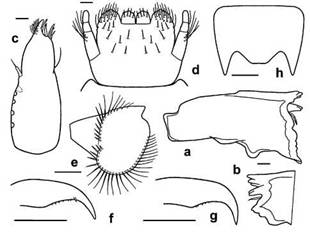The revision of Leptohyphidae phylogeny and taxonomy is in progress, and there are a lot of new species waiting to be described (Dias et al., 2019). The description of the larvae of two species here presented is intended as a contribution to this revision. The investigated material is preserved in 75% ethanol. Specimens were collected in 1960 by Ernst Josef Fittkau (Tricorythopsis rondoniensis) and 1962 by F. Plaumann (Tricorythodes barbus). Drawings were made by using Photo Filter 6.5.2. All the material is deposited in the entomological collection of Instituto de Biodiversidad Neotropical, Tucumán, Argentina (IBN).
Tricorythodes barbus Alien (Figs. 1-2)
Tricorythodes barbus Allen, 1967: 373; Molineri, 2002: 278; Domínguez et al., 2006: 307; Dias et al., 2019: 43.
Tricorythodes (Tricorythodes) barbus; Allen & Murvosh, 1987: 36.
Tricoryhyphes barbus; Wiersema & McCafferty, 2000: 353.
Material examined. Brazil, Santa Catarina state, Aguas Brancas, 27°56'S, 49°34'W, xii.1962, Plaumann leg., 1 larva (IBN).
Previous known distribution. Argentina (Misiones), Brazil (Santa Catarina).
Description. Larva of medium stage, body length 6.0 mm. Coloration and pigmentation are not preserved. Habitus: elongated (Fig. 1a). Head: Genae semi-circular, strongly bulging out (Fig. 1a). Anterior margin of labrum forming two semi-circular protrusions with a short straight anteromedian emargination; laterally with long, thin, bowed bristles, submedially with short comb-shaped ones (Fig. 2h, i). Mandibles (Fig. 2f, g), particularly the left one, moderately elongated with few long bristles on lateral margin; in both mandibles subapical incisivus with two denticles, apical incisivus of right mandible with three, of left mandible with four denticles. Maxilla (Fig. 2c-e): galealacinia and stipes equal in length, stipes abruptly narrowed, galealacinia apically densely provided with thin, strongly bowed bristles, palp three segmented with a very short apical seta (Fig. 2e). Labium (Fig. 2a) with small glossae and paraglossae scarcely stepped; postmentum moderately broadened, sides provided with long bowed bristles, antero-lateral corners moderately protruding; palps three segmented. Hypopharynx (Fig. 2b) with broadly rounded superlinguae; anterior margin of the latter straight with a dense row of short and very short bristles, superlinguae with long medially bowed ones. Thorax: Sides of pronotum straight or slightly concave, anterolateral corners rounded and protruding anteriorly (Fig. 1a). Fore femur relatively short, a little more than twice as long as wide (Fig. 2j), with an oblique transverse row of long bristles and very long ones on hind margin; the latter rounded angled. Mid and hind femora with long setation as in Fig. 1a. Claws slender and scarcely bowed, with two subapical denticles (Fig. 2k). Abdomen: Lateral flanges on segments II-VI, on segments V and VI posteriorly protruding and rounded; margins provided with moderate to long bristles. Posterolateral spines on segments VII-IX, inconspicuous short, and triangular. Hind margin of sternum IX medially cut or slightly concave, densely provided with medially bent bristles (Fig. 1b). Hind margin of tergum II medially with moderate to long bristles (omitted in Fig. 1a). Operculate gills are shaped triangular and nearly meeting medially; hind margin and an antero-medial field densely provided with long bristles. Gill formula (Fig. 2l-o): 2, 3, 3, 3, 2. Gill III-V, with more or less triangular larger lamellae (dorsal ones); ventral lamella basolaterally with a small semicircular protrusion. Both lamellae of gill VI rounded. Hind margins of terga VI-VIII provided with long or very long bristles, tergum VI only medially, VIII mainly laterally; tergum VII additionally with sublateral groups of shorter bristles (Fig. 1a).

Fig. 1: Tricorythodes barbus, larva. a. habitus, dorsal view. b. abdomen, ventral outline. Scale = 1 mm.

Fig. 2: Tricorythodes barbus, larva. a. labium, ventral view. b. hypopharynx, ventral view. c. maxilla, ventral view. d. galelacinia, anterio-medial part. e. maxillary palpus. f. left mandible, dorsal view. g. right mandible, dorsal view. h. labrum, anterior part. i. comb-shaped bristles from antero-submedial margin of labrum. j. fore femur, dorsal view. k. fore claw. l. gill II, ventral view. m. gill III, ventral view. n. gill V, ventral view. o. gill VI, ventral view. Scale = 0.1 mm.
Taxonomic notes. We are assigning the new material here reported to the species T. barbus Allen, 1967because the abdominal flanges are rounded apically and present on segments III-VI, additionally it presents large rounded projection on anterolateral corners of pronotum and in the tarsal claw only the subdistal subapical denticles are present (one denticle at each side). Tricorythodes barbus is included in the condylus group (Dias et al., 2019), with T. molinerii Dias & Salles, 2006, T. diasae Gongalves et al., 2010, T. ocellus Allen & Roback, 1969, and T. condylus Allen, 1967. The two first species are similar to T. barbus, but they present more acute flanges on segments III-VII. Additionally, T. molinerii has lateral margins of abdominal segments III-VII expanded, with posterolateral spines on VII-VUI, and T. diasae has tarsal claws with 3-4 marginal denticles and 1-2 submarginal denticles, and lateral margins of abdominal segments III-VI expanded, with posterolateral spines on VII-VUI. Tricorythodes ocellus, besides showing a different distribution (Peruvian Andes), present large ocelli, a completely grayish operculate gill and a two segmented maxillary palpus without apical seta. The fore femur of the specimens here reported is more robust than that drawn for T barbus (Molineri, 2002), but this can be assumed as instar differences (younger instars show stouter femora in Tricorythodes, and other genera of the family). Furthermore, the locality where it was collected is near the localities of T barbus (T molinerii and T diasae are known from localities northern to those of T barbus).

Fig. 3: Tricorythopsis rondoniensis larva, habitus. a. mature larva redrawn from Dias et al. (2009). b. young specimen reported here. Scale = 1 mm.
Diagnosis. The diagnosis of T barbus (Molineri, 2002; Dominguez et al., 2006) is not modified here.
Tricorythopsis rondoniensis (Dias, Cruz & Ferreira, 2009) (Figs. 3-4)
Tricorythodes rondoniensis Dias, Cruz & Ferreira, 2009: 128; Shimano, Salles & Cabette, 2011: 247.
Tricorythopsis rondoniensis Belmont, Salles & Hamada, 2012: 292; Zúñiga & Torres-Zambrano, 2015: 37; Dias, Cárdenas López & Laython, 2016: 197.
Material examined. Brazil, Amazonas state, Rio Negro, mouth of Rio Arara at Rio Negro, about 80 km NW of Manaus, 06.x.1960, Fittkau leg., 2 larvae (IBN).
Previous known distribution. Brazil (Amapá, Amazonas, Mato Grosso, Roaima, Rondonia), Colombia (Amazonas, Guaviare, Meta).
Description. Larva of medium stage, body length 2.0 mm. Coloration and pigmentation are not preserved. Habitus: body depressed and discoidal (Fig. 3a-b). Head: Genae slightly bulging out. Labrum semiovoidal, with slight median indentation; margin of indentation with very short blunt, ventrally bent bristles, laterally followed by short to moderate bristles, the shorter median ones frayed. Mandibles (Fig. 4a, b) without any setation; basal part elongated; in both mandibles apical incisivus with three and subapical incisivus with two denticles, prosthecae very thin, filiform, the right one slightly pinnate. Maxilla (Fig. 4c) basally broadened, setation reduced, palp one segmented with apical seta. Labium (Fig. 4d) with small glossae, paraglossae large and domed, both with bulged margins; palps three segmented. Thorax: Sides of pronotum concave, anterolateral corners rounded and slightly protruding laterally (Fig. 3a-b). Fore femur (Fig. 4e) with a basal part with distally diverging margins, separated by a ridge from the strongly broadened irregularly ovoid apical part, that is forming an ovoid, slightly embossed plate with a triangularly protruding anterolateral corner. This plate is bordered by basally more or less broadened, pinnate bristles of different length. The medial ones are short, forming a medially interrupted transverse row, the others moderate to long. Mid and hind femora semicircular, hind margins strongly curved, provided with long pinnate bristles, the longest on fore margin are twice as long as those on hind margin (Fig. 3a-b). Long pinnate bristles can be observed also on tibiae (on mid and hind tibiae not drawn in Fig. 3b). Fore claw moderately bowed, with one subapical denticle and few very small marginal microdenticles (Fig. 4f). Hind claw stronger bowed, without subapical denticle (Fig. 4g). Abdomen (Fig. 3a-b): Abdominal segments VII-IX with long and strong posterolateral spines, densely provided with long bristles, tips not bent medially. Processes on anterior segments, covered by operculate gills, abruptly shortened and without bristles. Terga MI-VM with posteromedian tubercles. Hind margin of all terga with strong denticles. Ends of hind margin of tergum III bent anterolaterally, forming a ridge bordering anteromedian margin of operculate gill. Hind margin of sternum IX medially cut or slightly concave, widely projected by the posterolateral spines (Fig. 4h). Operculate gill semioval, lateral margin rounded (Fig. 3a) or straight (Fig. 3b).
Taxonomic notes. Four species in Tricorythopsis present a discoidal depressed body and wide flattened femora bordered by long spines: T. yacutinga Molineri, 2001, T. araponga Dias & Salles, 2005, T. rondoniensis (Dias, Cruz & Ferreira, 2009), and T. nupem Araujo & Dias, 2020. The last three also present dorsal tubercles on some abdominal terga (T rondoniensis on terga III-VII, T. araponga and T. nupem on terga V-VII). Tricorythopsis bahiensis Dias, Salles & Ferreira, 2008 also presents wide flattened femora bordered by long spines, but the body is not discoidal. Further characteristics define each of the species: T yacutinga only have submarginal subdistal denticles in tarsal claws (in the other three species the marginal subbasal row is also present), T nupem shows a median transversal row of setae on dorsal surface of mid and hind femora. Tricorythopsis rondoniensis does not have the weak transverse line on operculate gill that characterizes other species in the genus. Tricorythopsis araponga is rather similar to T nupem, except for the transversal rows of dorsal spines on femora, also it shows less denticles on marginal row of tarsal claw: 4-6 in T. araponga, instead of 9-10 in T nupem. The specimens here reported present tubercles on abdominal terga III-VII (as T rondoniensis). Tarsal claws with 5-6 marginal subbasal + 0-1 submarginal subdistal denticles is almost the same in T rondoniensis (Dias et al., 2009, 2016), except that a submarginal subdistal denticle was never reported before for this species. Here, one of the claws presents it and the other does not, so it is assumed as an intraspecific variation of T rondoniensis. Further differences with T. rondoniensis in the outline and body proportions (compare Figs. 3a and 3b) are normal differences between youngest instars and grown nymphs in Leptohyphidae.

Fig. 4: Tricorythopsis rondoniensis, larva. a. right mandible, dorsal view. b. left mandible, apex. c. maxilla. d. labium, apical part. e. fore femur, dorsal view. f. fore claw. g. hind claw. Scale = 0.1 mm.
Diagnosis. Tricorythopsis rondoniensis can be distinguished from all the other larvae in the genus by the combination of the following characteristics: 1) body discoidal depressed and with wide flattened femora; 2) tarsal claws with 5-6 marginal subbasal denticles and none or 1 submarginal subdistal denticle; 3) weak transverse line on operculate gill absent; 4) mediodorsal tubercles present on terga III-VII.












 uBio
uBio 

